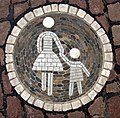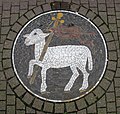Cobblestone mosaics (Freiburg im Breisgau)

Cobblestone mosaics can be found throughout Freiburg im Breisgau. Most mosaics are embedded in the cobblestone pavement of the city centre of Freiburg.
History[edit]
These mosaics are commonly attributed to the paver Alois Krems, who lived in Freiburg in 1858. His work was inspired by pavings he had seen during his time as an apprentice in southern France. In the late 19th century, major road reconstruction works took place in Freiburg, during which the Bächle were relocated from the centers to the edges of the roads. As a result, several roads in different parts of town (Wiehre, Herden, Neuburg) were repaved with cobblestone between 1901 and 1911. The new basalt pavements are streaked with veins of white marble. Furthermore, they feature the year in which they were constructed. Even though the bombing of Freiburg on 27 November 1944 destroyed about 38km of roads and pavements, many of the pavings survived and can still be admired today.

The tradition of cobblestones enjoyed a revival during the 1970s when the old city of Freiburg was turned into a pedestrian zone. For instance, the pavements of Kaiser-Joseph-Straße, Freiburg's main shopping street, was paved with red porphyry and decorated with bands of white marble and smaller cobbles found in the Rhine. Larger cobblestones from the Rhine were also used to pave the Minster square. In 2012 a path leading to the main entrance of the minster was evened out so that the handicapped can access the church more easily.[1]
At the beginning of the Habsburgerstraße a mosaic on the pavement marks the course of the 48th parallel north.[2]
Origins of the Stones[edit]

The round mosaics, decorative bands and at times even the paving of whole alleys consist mostly of coloured cobblestones from the Rhine. In the past, the stones used to be extracted from the Rhine flood plains close to Breisach in periods of low flow. However, this has become more difficult nowadays since the stock has depleted. Occasionally, new cobbles are obtained from gravel pits in the Rhine basin. Furthermore, stones that were replaced by asphalt are stored and reused. Other stones like porphyry, granite, basalt and marble have been purchased in Europe in the past and are obtained from all over the world today for economic reasons. Sporadically, artificial stones are used for details.
Processing[edit]
To attain flat ellipsoidal cobbles, the paving stones are either cut by machine and have their edges smoothed in a drum mixer, or they are manually broken down and trimmed underneath to improve their stability. They are cut to be 6 to 12 cm long and 2 to 3 cm wide. The depth of each stone needs to be at least 2/3 of its length. The finished cobbles are set in the ground with their flat side facing up to create a smooth surface. Bigger stones are processed by machines. Usually, the cobbles are set in a sand subfloor. Occasionally, as is the case in Kaiser-Joseph-Straße a mortar subfloor is used. The cobbles are pressed into the subfloor using a paving hammer.

In the city centre of Freiburg, round mosaics in the paving can be found almost everywhere. These mosaics often show symbols of trade or historical references to the building that lies behind it. Some of these mosaics have mere ornamental character, others display emblems, coat of arms or short brand names.

If these round mosaics take great effort to piece together they are assembled with the help of a wooden stencil in a steel ladle filled with mortar. This technique has been used in Freiburg since the 1970s. This way the mosaics can be prepared at a builder's yard and do not have to be destroyed for road work. Each of these portable mosaics weighs ca. 400 kg. Freiburg's twin cities each were given such a mosaic showing Freiburg's coat of arms. Commissioned mosaics for cities in the vicinity are also produced in Freiburg.
-
Wooden Stencils
-
Bertoldstraße, Freiburg im Breisgau
-
Freiburg's coat of arms in a steel ladle (unfinished)
-
Gifts to Freiburg's sister city: Mosaics in Madison, WI
-
Traffic sign
-
University of Freiburg
-
Shoe shop, Freiburg im Breisgau
-
Book shop, Freiburg im Breisgau
-
Ornaments, Freiburg im Breisgau
-
Brand name, Herrenstraße, Freiburg im Breisgau
-
Ice cream parlour, Freiburg im Breisgau
-
Butcher's, Freiburg im Breisgau
References[edit]
- ^ Frank Zimmermann: Barrierefreies Freiburg? Da fehlt noch ein Konzept, Badische Zeitung, 6 September 2012, retrieved 20 December 2013
- ^ "48. Breitengrad in Freiburg - freiburg-im-netz.de" (in German). Retrieved 9 May 2016.
Marianne Willim, Rüdiger Buhl (1999), Pflastermosaiken in Freiburg (in German), Freiburg: Promo Verlag GmbH, ISBN 3-923288-24-7












